T-Harrier
Harrier T.2/T.2A/T.2N/T.3/T.4N/T.8
Two Seater Trainer
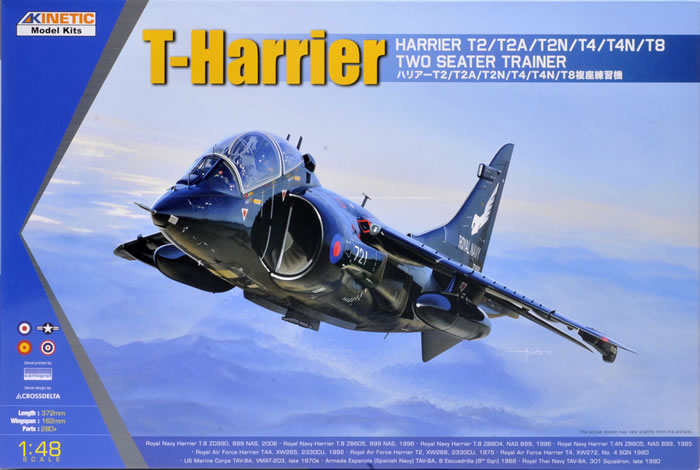
Kinetic, 1/48 scale
S u m m a r y |
| Item No. |
Kinetic Model Kits Item No. K48040 - T-Harrier: Harrier T.2/T.2A/T.2N/T.3/T.4N/T.8 Two Seater Trainer |
| Contents and Media: |
Around 300 parts in grey plastic and 20 parts in clear; markings for 10 aircraft. |
| Scale |
1/48 |
| Price: |
USD$39.99 plus shipping available online from Lucky Model |
| Review Type: |
FirstLook |
| Advantages: |
High quality moulding; nicely detailed; new wing, fuselage and detail sprues; recessed panel lines and rows of rivets; optional position flaps (extended or closed); straightforward parts breakdown; high quality decals designed by Crossdelta and printed by Cartograf. |
| Disadvantages: |
|
| Recommendation: |
This is another really nice modern subject from Kinetic, and the first time that we can build a two-seater Harrier straight from the box in this scale. Kinetic's Harriers are well detailed, offer many useful options and alternative position parts, and provide a wealth of ordnance. Engineering appears straightforward and it should not be a difficult build. At less that USD$40.00, it is a bargain too! |
Reviewed
by Brett Green

HyperScale is proudly supported by Squadron.com
Two-seat Harriers were operated for training purposes.
The body was stretched and a taller tail fin added.
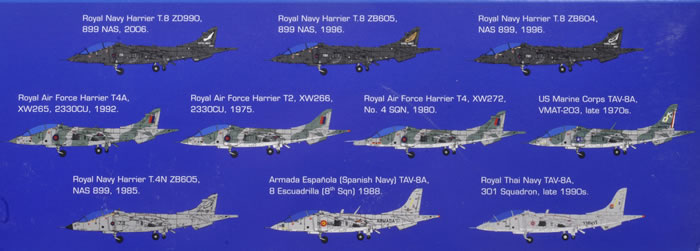
The RAF trained in the T.2 and T.4 versions, while T.4N and T.8 were training versions the Navy's Sea Harrier, with appropriate fittings. The US and Spain flew the TAV-8A and TAV-8S, respectively.
Variants are as follows:
-
Harrier T.2 - Lengthened two-seat training version for the RAF, powered by Pegasus Mk 101 engine. Development Builds XW174-XW175 and first batch XW264-XW272 fitted with the short fin. XW925-XW927, XW933-XW934 had the tall fin which had been trialled on XW175. All had the pointed tail-sting.
-
Harrier T.2A - Upgraded T.2, powered by a Pegasus Mk 102. No external airframe changes.
-
Harrier T.4 -Two-seat training version for the Royal Air Force, equivalent to the GR.3, with Pegasus Mk 103 engine. Serials: XW175, XW265-XW272, XW925-XW927, XW933-XW934 upgraded T.2As; fourteen new builds XZ145-XZ147 (tall fin), XZ445, ZB600-ZB603, ZD990-ZD993. Laser seeker nose and radar warning receivers on fin and the tail-sting fitted to non-T.4A airframes.
-
Harrier T.4A - T.4 without laser seeker nose or radar warning receiver tail-sting but with the (empty) fairing on the fin. Being lighter these were used for flying training only. Serials: XW175, XW265-XW266, XW268, XZ147, XZ445, ZD990.
-
Harrier T.4N - Two-seat training version for the Royal Navy, with avionics (excluding radar) based on Sea Harrier FRS.1, active RWR on the fin and in the tail-sting. Serials: XW266-XW268, XW927, ZB601, ZB603, ZD992 upgraded from T.4/ T.4A. ZB604-ZB606 were new build T.4Ns.
-
Harrier T.4(I) - Conversion of ex-RAF T.4 airframes by BAE Systems, for the Indian Navy. Attrition replacements for India's Harrier T.60. Delivered from May 2003; included IN655 with a laser nose.
-
Harrier T.8 - Naval trainer modified fitted with Sea Harrier F(A).2 avionics plus the Doppler panel bulge ahead of the front undercarriage bay. Upgraded airframes: ZB603-ZB605, ZD990-ZD993.
-
Harrier T.52 - Two-seat company demonstrator of an export variant of the T.2, originally Pegasus 102 powered but uprated to Pegasus 103 following an accident in 1971, one built first flown 15 September 1971; registered G-VTOL. As a non-military airframe it had civilian avionics fitted, hence the extra aerials on the upper fuselage.
-
Harrier T.60 - Export version of the T4N two-seat training version for the Indian Navy. Serials: IN651-IN654.
-
TAV-8A Harrier - Two-seater training version for the USMC, powered by a Pegasus Mk 103. Company designation Harrier Mk 54. Eight built. Serials: 159378-159385.
-
TAV-8S Matador - Export version of the TAV-8A Harrier for the Spanish Navy. Later sold to the Royal Thai Navy. Spanish Navy designation VAE-1 Matador. Company designation Harrier Mk 54. Serials: 159563-159364.
The important thing to remember is that from T.2 to T.4 the designation was determined by the type of Pegasus fitted and NOT the airframe shapes!
Adapted from Wikipedia with input from Nick Greenall, IPMS(UK) Harrier Special Interest Group
Kinetic released their excellent 1/48 scale Sea Harrier FA2 in September 2014, followed by an equally good Sea Harrier FRS.1 in October 2015.
With the schedule taking a break in 2016, Kinetic has now followed up with the two-seater Harrier trainer. This is a welcome variation as it is the first Harrier two-seater available as a 1/48 scale injection moulded kit, and also the first RAF Harrier from Kinetic.
This new kit from Kinetic comprises around 300 parts in light grey plastic, 20 parts in clear and a photo-etched fret. Markings for all Royal Navy and Indian Navy Sea Harrier FRS.1s are are included.
Compared to the previous Kinetic Sea Harriers, this kit features a brand new fuselage, fin and detail sprues. The wing appears to be new too, or at least had the moulds cleaned up, featuring sharper recessed detail and less flash. A number of the generic sprues are shared with the earlier release.
The fuselage is presented as two main halves plus a separate nose cone. This is a new fuselage and dedicated to the two-seater versions. The kit also includes the tall fin, the RWR fin and the original fin.
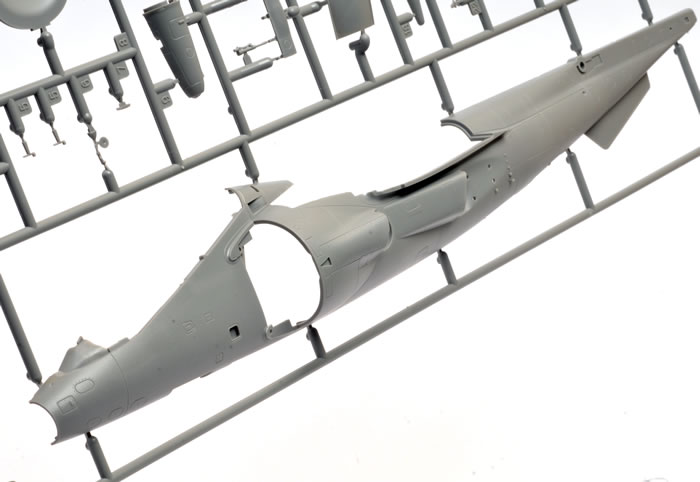
The new wing (pictured below) appears to have even finer and sharper recessed panel lines, and smoother surface. The old wing is included too, so make sure you use the right one!
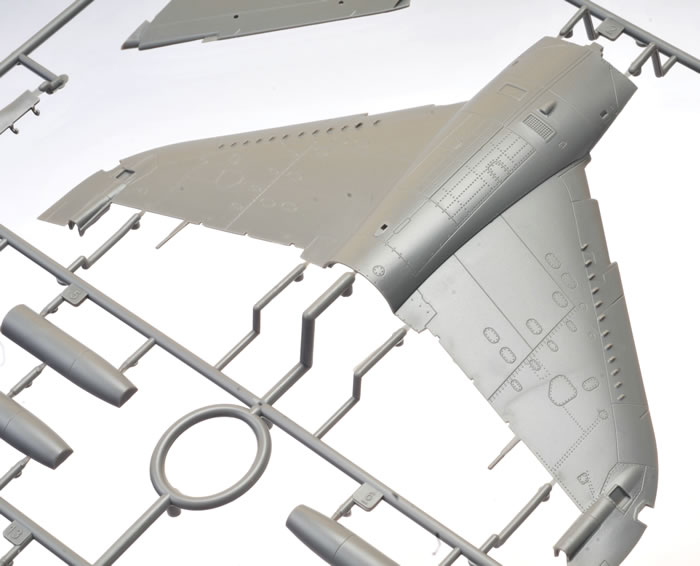
In common with the Sea Harrier FA2, surface detail looks very nice, with recessed panel lines, vents and rivets over the airframe.
Moulding quality is high, with minimal ejector pin circles, seam lines or sink marks. There is only a little fine flash to clean up here and there.
Some of the moulding is really clever too, notably the one-piece nozzles. All four nozzles are connected by a rotating mechanism.
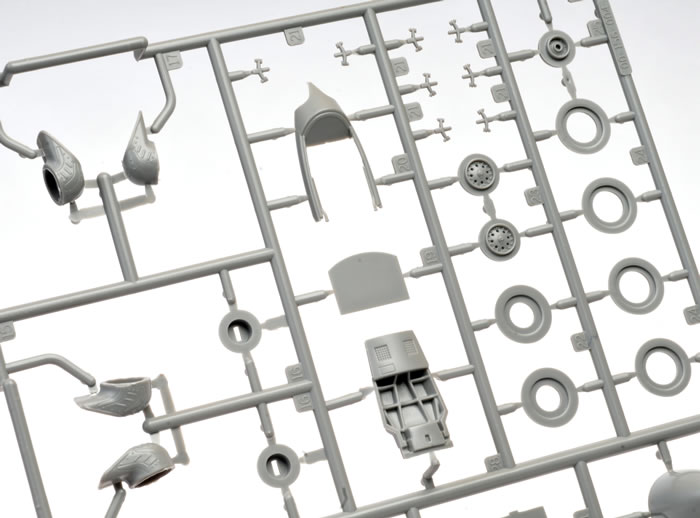
The new two-seat cockpit detail is nice straight from the box, with raised detail on the side consoles and instrument panels; and excellent moulding on the sides of the ejector seat. Photo-etched harness straps are also included - a first for Kinetic's Harrier family.
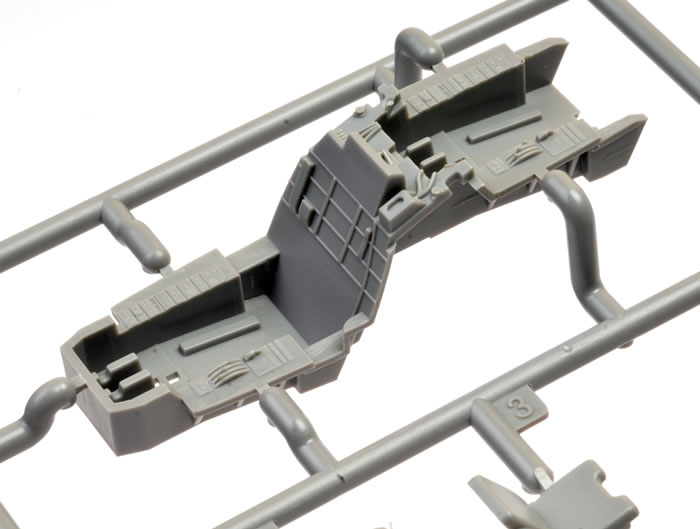
The canopy is split into windscreen and opening section. The latter features the prominent detonation chords moulded into the top.
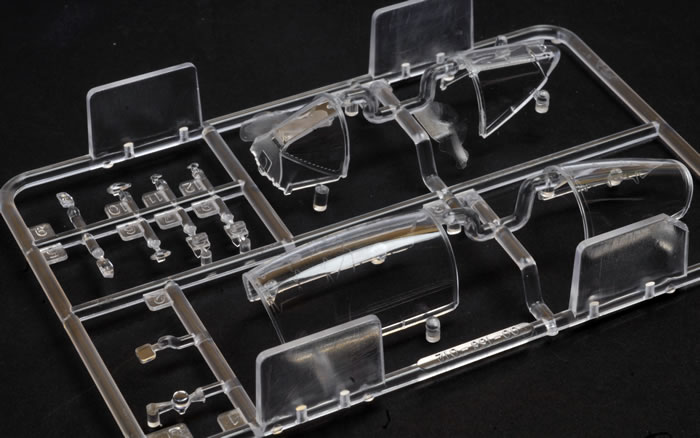
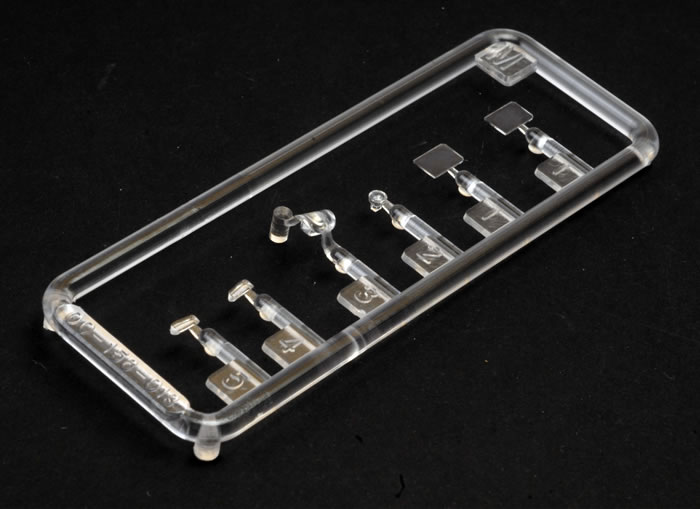
The stressed metal effect on the nozzle blast shields looks great.
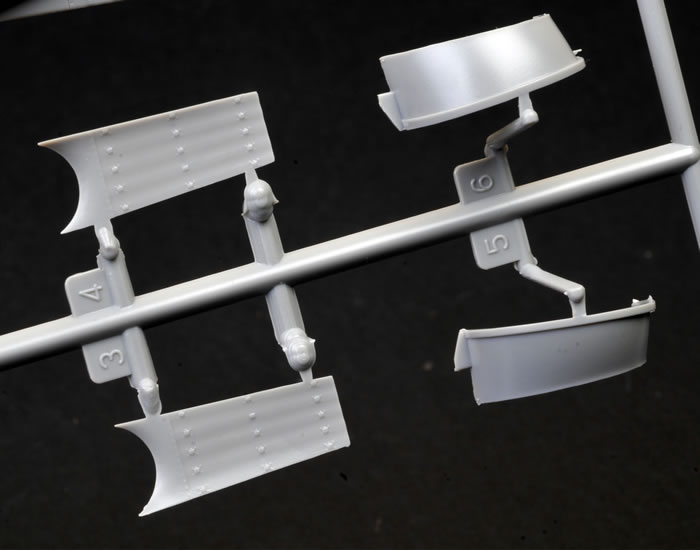
Optional parts are provided for open or closed auxiliary blow in doors; open or closed air brakes; and the control surfaces and flaps are all offered as separate parts, allowing them to be posed to taste. Landing gear doors may be fixed open or closed too.
The newly designed photo-etched fret provides additional detail parts including scale thickness wing fences and two full sets of harness straps.
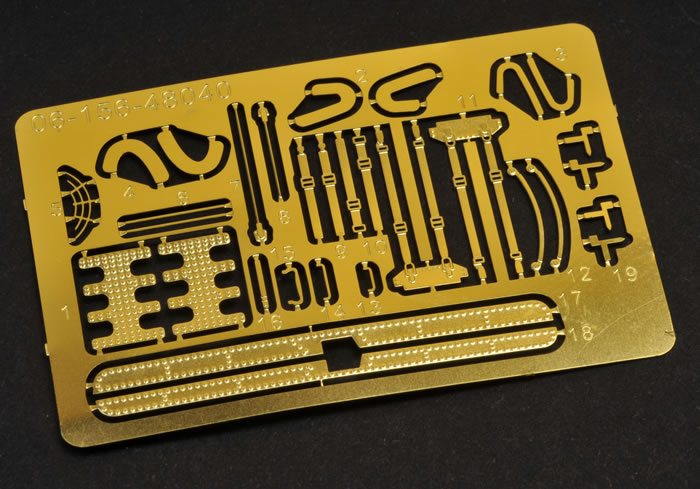
Of the 300-odd grey plastic parts, 140 are dedicated to ordnance. There appear to be bombs and rocket pods that might relate to a possible RAF Harrier release in the future.
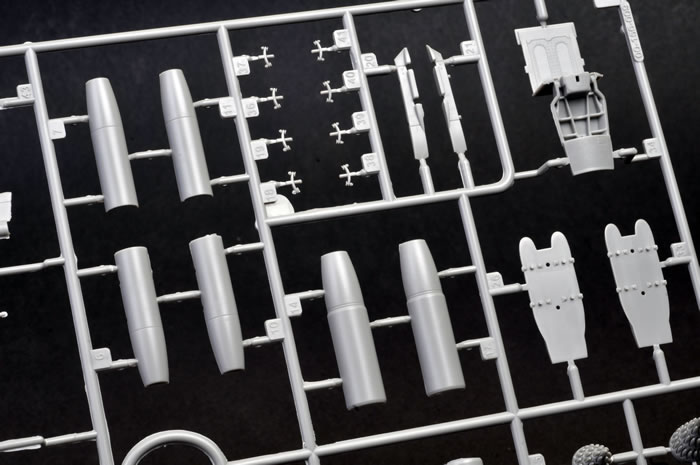
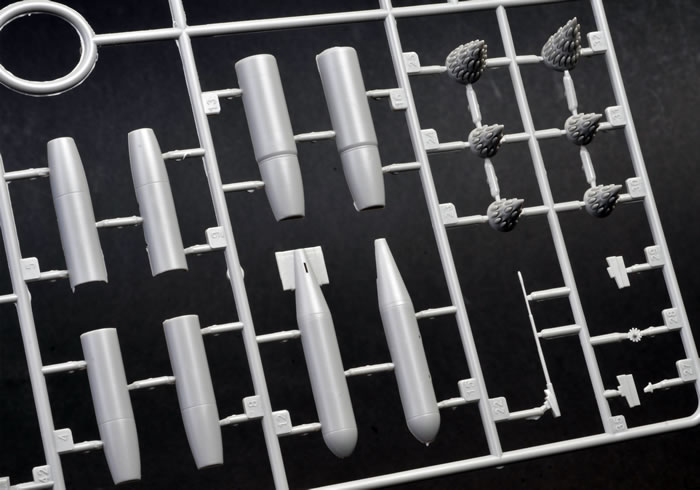
Relevant ordnance for the two-seater Harrier are the 100 Gallon and 190 Gallon fuel tanks and the Gun Pod, so you'll have plenty of weapons to add the spares box!
Markings
Decals are designed by Crossdelta and luxuriously printed by Cartograf.
The model may be finished in a good selection of operational schemes.
The main camouflage variations are noted below, but thanks to the inclusion of a number jungle in various colours and sizes plus individual serial numbers, markings for many more RAF two-seater Harriers may be depicted.
The following aircraft are finished in overall Gloss Black:
-
Royal Navy Harrier T.8 ZD990, 899 NAS, 2006.
-
Royal Navy Harrier T.8 ZB605, 899 NAS, 1996.
- Royal Navy Harrier T.8 ZB604, NAS 899, 1996.
The following aircraft is finished in overall Satin Dark Sea Grey overall:
The following aircraft is finished in wraparound Dark Green and Dark Sea Grey:
- Royal Air Force Harrier T4A, XW265, 233OCU, 1992.
The following aircraft are finished in Dark Green and Dark Sea Grey upper surfaces and Light Grey below:
- Royal Air Force Harrier T2, XW266, 233OCU, 1975.
-
Royal Air Force Harrier T4, XW272, No. 4 SQN 1980.
-
US Marine Corps TAV-8A, VMAT-203, late 1970s.
The following aircraft are finished Gull Grey upper surfaces and White below:
-
Armada Espanola (Spanish Navy) TAV-8A, 8 Escuadrilla (8th Sqn) 1988.
-
Royal Thai Navy TAV-8A, 301 Squadron, late 1990.
Colour callouts are offered for Vallejo and GSI Creos (I believe this is Gunze-Sangyo acrylic) paints.
Ticks and Crosses - Additional Notes by Nick Greenall from IPMS(UK) Harrier SIG
The Good...
The BIG POSITIVE! - For the first time ever you have a 1/48th scale first generation Harrier two-seater kit which will enable you to make all marks of the aircraft - the T2, T2A (more powerful engine), T4 (more powerful engine again), T4A - pointed nose, RWR fin, original tail-sting, T4N (Navalised T4 for SHAR FRS1 training) and T8 (uprated for FA2 training with Doppler panel bulge ahead of front u/c bay) - with two nose options (original/LRMTS), 3 fin options (original/tall/RWR fitted), 2 tail-sting options (original/RWR) and a separate Doppler panel for the T8.
Overall, the fuselage, cockpits, canopies, noses, fins and tail-stings are accurate. The kit instructions do provide guidance on the nose/fin/tail-sting combination needed for each marking provided.
Both canopies have laser-cut MDCs in them - beautifully rendered.
The BIG thing to remember with first generation two-seater Harriers is that the mark reference T2-4 does NOT indicate what nose/fin/tail-sting combination was fitted; but refers to the mark of Pegasus engine fitted. That's why you see T2s and T4s with original and tall fins, original or laser noses and original or RWR fitted tail stings. Yes, it's a minefield! BUT... DON'T PANIC! The Harrier SIG has this covered and will be publishing guidance at Scale ModelWorld.
Yes, you will also be able to make G-VTOL from the kit, with a few scratch-built additions; the VAAC Harrier two, with even more scratch-built items, e.g. the under fuselage pods. As mentioned above, you can also make TAV-8A and TAV-8S from the kit, with replacement seats - Wingman WMF48002 Stencel III-S Seats. Sadly, no Indian Navy T60 markings included but, if you have a Kinetic FRS1 kit you could raid that for markings.
The Not So Good...
-
Inboard pylons - Yes, they have the kinked leading edge of the type used exclusively by the Royal Navy single seat Sea Harrier and are not representative of the two-seater or GR1/3 / AV-8A/S pylons. To fix > A bit of judicious cutting and sanding.
-
Rocket pods - These were wrong in the SHAR FRS1 kit and are on the same sprue form that kit as the FRS1 type wings needed for the two-seater, so Kinetic have added an existing sprue to the box, rather than use a new sprue. In the FRS1 they were meant to be the RN 2-inch pods (NOT Matra 155s) but someone clearly mis-interpreted things. No easy fix!
-
The wing outriggers appear to be moulded with groundlocks fitted which is OK for a parked aircraft but not good for a taxying jet diorama. They may also have the SHAR tie-down rings on.
-
Seat straps - we got the long versions which can be cut down; rather than the other way around!
-
IFR probe - Despite saying the longer two-seater version was needed, only a single seat probe has been provided. To fix > add a short extension from rod.
-
And, finally... modellers, please, please do not drop BOTH ailerons on the two-seater or any other first generation Harrier, i.e. GR1, GR3, AV-8A, AV-8S, single seaters. The ability to drop both ailerons was a Harrier II development ONLY, i.e. AV-8B series, GR5/7/9 and the two seaters - TAV-8B, T10/12.
Good things come to those who wait... like this kit. For which, I must say a very big THANK YOU! to Raymond and all his team at Kinetic, especially Laurent Stern, for doing what no British or other kit manufacturer has yet done, despite many requests... Kinetic has given us not only the best SHAR kits yet produced but have now given us a first ever styrene kit in 1/48th scale of a two-seater first generation Harrier. Yes, with the above items all fixed, it could have been 100%.
But, we have an accurate airframe to work with and, we are all model makers, aren't we? So what's to stop all/any of us from being able to make some fantastic Harrier two-seater models from the kit…?
Nick Greenall
This is another really nice modern subject from Kinetic, and the first time that we can build a two-seater Harrier straight from the box in this scale.
Kinetic's Harriers are well detailed, offer many useful options and alternative position parts, and provide a wealth of ordnance. Engineering appears straightforward and it should not be a difficult build.
At less that USD$40.00, it is a bargain too!
Thanks to Lucky Model for the sample
Review Text and Images Copyright © 2017 by
Brett Green
except Variants text and "Ticks and Crosses - Additional Notes" by Nick Greenall
Page Created 30 October, 2017
Last updated
3 November, 2017
Back to HyperScale Main Page
Back to Reviews Page

|
Home
| What's New |
Features |
Gallery |
Reviews |
Reference |
Forum |
Search